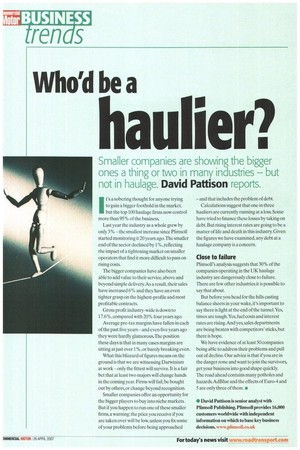Who'd be a
Page 64

If you've noticed an error in this article please click here to report it so we can fix it.
haulier?
Smaller companies are showing the bigger ones a thing or two in many industries — but not in haulage. David Pattison reports.
It's a sobering thought for anyone trying to gain a bigger foothold in the market, but the top 100 haulage firms now control more than 95% of the business.
Last year the industry as a whole grew by only 3% — the smallest increase since Plimsoll started monitoring it 20 years ago. The smaller end of the sector declined by 1%, reflecting the impact of a tightening market on smaller operators that find it more difficult to pass on rising costs.
The bigger companies have also been able to add value to their service, above and beyond simple delivery. As a result, their sales have increased 6% and they have an even tighter grasp on the highest-profile and most profitable contracts.
Gross profit industry-wide is down to 17.6% , compared with 20% four years ago.
Average pre-tax margins have fallen in each of the past five years — and even five years ago they were hardly glamorous.The position these days is that in many cases margins are sitting at just over 1%, or barely breaking even.
What this blizzard of figures means on the ground is that we are witnessing Darwinism at work — only the fittest will survive. It is a fair bet that at least two majors will change hands in the coming year. Firms will fail, be bought out by others, or change beyond recognition.
Smaller companies offer an opportunity for the bigger players to buy into niche markets. But if you happen to run one of these smaller firms, a warning: the price you receive if you are taken over will be low, unless you fix some of your problems before being approached — and that includes the problem of debt.
Calculations suggest that one in three hauliers are currently running at a loss. Some have tried to finance these losses by taking on debt. But rising interest rates are going to be a matter of life and death in this industry. Given the figures we have examined, any debt at a haulage company is a concern.
Close to failure
Plimsoll's analysis suggests that 30% of the companies operating in the UK haulage industry are dangerously close to failure. There are few other industries it is possible to say that about.
But before you head for the hills casting balance sheets in your wake, it's important to say there is light at the end of the tunnel.Yes, times are tough. Yes, fuel costs and interest rates are rising. And yes, sales departments are being beaten with competitors' sticks, but there is hope.
We have evidence of at least 50 companies being able to address their problems and pull out of decline. Our advice is that if you are in the danger zone and want to join the survivors, get your business into good shape quickly. The road ahead contains many potholes and hazards.AdBlue and the effects of Euro-4 and 5 are only three of them.• • David Pattison is senior analyst with Plimsoll Publishing. Plimsoll provides 16,000 customers worldwide with independent information on which to base key business decisions. ww vv.pihnsoll.co.uk






















































































































































































